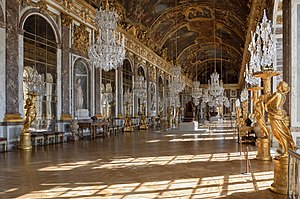
Back Paleis van Versailles Afrikaans قصر فرساي Arabic قصر فرساى ARZ Palaciu de Versalles AST Versal sarayı Azerbaijani Puri Versailles BAN Schloss Versailles BAR Версаль (палаца-паркавы комплекс) Byelorussian Вэрсальскі палац BE-X-OLD Версайски дворец Bulgarian
| Palace of Versailles | |
|---|---|
Château de Versailles (French) | |
|
Garden façade and fountains; Hall of Mirrors | |
 Interactive fullscreen map | |
| General information | |
| Architectural style | Classicalism and Baroque |
| Location | Versailles, France |
| Coordinates | 48°48′17″N 2°7′13″E / 48.80472°N 2.12028°E |
| Construction started | 1661 |
| Owner | Government of France |
| Website | |
| en | |
| Official name | Chateau and Park of Versailles |
| Criteria | Cultural: i, ii, vi |
| Reference | 83 |
| Inscription | 1979 (3rd Session) |
| Area | 800 ha (2,000 acres) |
| Buffer zone | 9,467 ha (23,390 acres) |
The Palace of Versailles (/vɛərˈsaɪ, vɜːrˈsaɪ/ vair-SY, vur-SY;[1] French: château de Versailles [ʃɑto d(ə) vɛʁsɑj] ⓘ) is a former royal residence commissioned by King Louis XIV located in Versailles, about 18 kilometres (11 mi) west of Paris, France.
The palace is owned by the government of France and since 1995 has been managed, under the direction of the French Ministry of Culture, by the Public Establishment of the Palace, Museum and National Estate of Versailles.[2] About 15,000,000 people visit the palace, park, or gardens of Versailles every year, making it one of the most popular tourist attractions in the world.[3]
Louis XIII built a hunting lodge at Versailles in 1623. His successor, Louis XIV expanded the château into a palace that went through several expansions in phases from 1661 to 1715. It was a favourite residence for both kings, and in 1682, Louis XIV moved the seat of his court and government to Versailles, making the palace the de facto capital of France. This state of affairs was continued by Kings Louis XV and Louis XVI, who primarily made interior alterations to the palace, but in 1789 the royal family and French court returned to Paris. For the rest of the French Revolution, the Palace of Versailles was largely abandoned and emptied of its contents, and the population of the surrounding city plummeted.
Napoleon, following his coronation as Emperor, used the subsidiary palace, Grand Trianon, as a summer residence from 1810 to 1814, but did not use the main palace. Following the Bourbon Restoration, when the king was returned to the throne, he resided in Paris and it was not until the 1830s that meaningful repairs were made to the palace. A museum of French history was installed within it, replacing the courtiers apartments of the southern wing.
The palace and park were designated a World Heritage Site by UNESCO in 1979 for its importance as the centre of power, art, and science in France during the 17th and 18th centuries.[4] The French Ministry of Culture has placed the palace, its gardens, and some of its subsidiary structures on its list of culturally significant monuments.
- ^ "Versailles". Dictionary.com. Retrieved 1 July 2021.
- ^ "The Public Establishment". Palace of Versailles. 31 October 2016. Retrieved 20 December 2021.
- ^ "Palace of Versailles (Château de Versailles)". Explore France. Government of France. 18 June 2021. Archived from the original on 18 December 2022. Retrieved 3 August 2021.
- ^ "Palace and Park of Versailles". UNESCO World Heritage Centre. United Nations Educational, Scientific, and Cultural Organization. Retrieved 9 October 2021.

